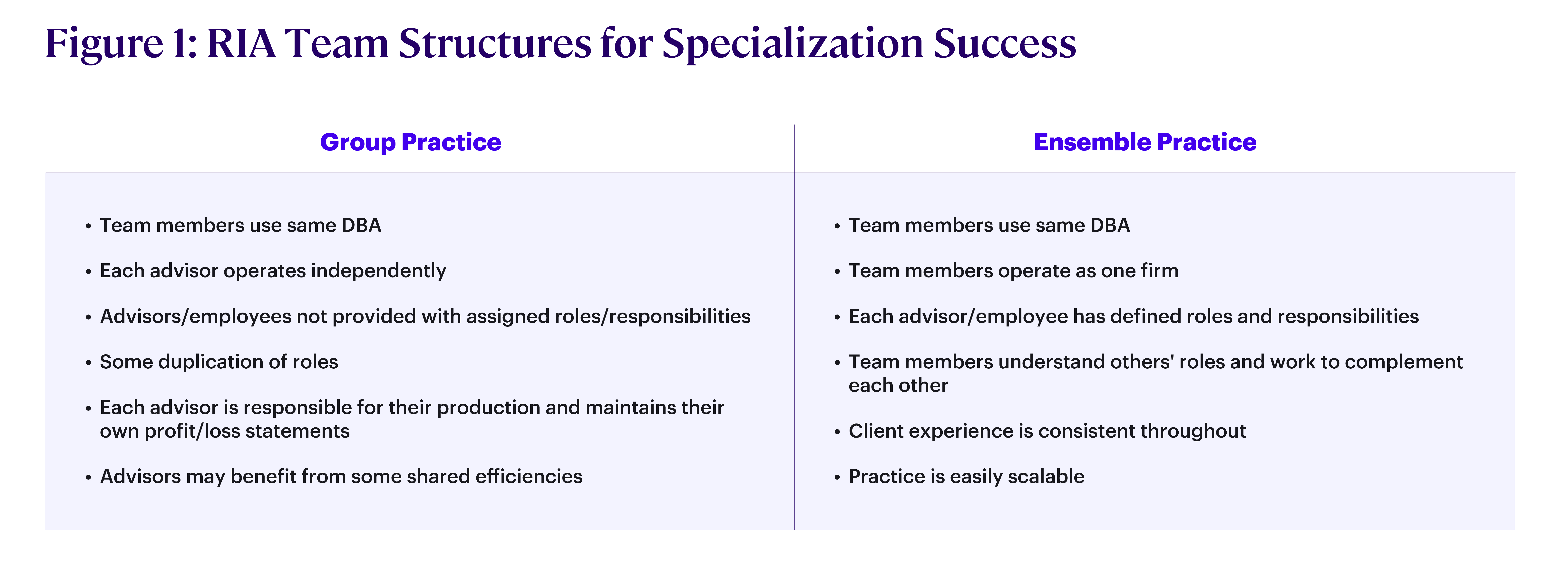The Optimal RIA Team Structure to Achieve Scalable Growth

Designing A Winning Team
Once you have decided to strategically grow in specialization, new questions come to mind–such as, “How do I expand my practice to deliver these services while achieving scale?” Answering this question involves evaluating your current firm structure.
As a sole practitioner, it is challenging to grow in specialization. Options include recruiting or forming alliances with advisors who already have specialized expertise or developing a long-term roadmap for expertise expansion that includes the development of new hires, such as a junior advisor.
RIAs with multiple advisors need to evaluate if their current team structure is conducive to delivering a wide array of specialized services. There are two primary RIA team structures. While they share some characteristics, you will notice they differ in many important aspects. (see Figure 1).

Building an ensemble team can be a long-term process. But for advisors, partnering with peers whose specializations complement their own can yield significant benefits.
To discover how you can build a true ensemble team and lay the groundwork for a more profitable, sustainable, and effective RIA, visit our RIA Resource Center now.
More From The College:
Get specialized retirement planning knowledge with our RICP® Program.
See our CFP® Certification Education Program.
Gain philanthropic and legacy planning knowledge with our CAP® Program.
Get the details of our WMCP® Program.
Look inside our CLU® Program.
Learn more about our ChFC® Program.
RIA Team Specialization and Education Plan

How to integrate specialization with individual roles and responsibilities
Making sure that your team has both the financial planning skills and business acumen they need to deliver specialized services demands an intentional and informed approach to training, upskilling, and lifelong learning.
The right financial education can help prepare team members for their various roles and support them as they move up the ranks. For example, an entry-level paraplanner may be responsible for:
- Client fact-finding and onboarding.
- Maintaining social media accounts.
- Preparing files for client meetings.
- Client servicing.
As such, they need to understand target marketing principles, ethical decision-making, current financial products, and major financial planning areas. A designation such as The American College of Financial Services Financial Services Certified Professional® (FSCP®) can help.
As the paraplanner moves into an associate advisor role, however, their responsibilities evolve to include:
- Inputting data into financial planning technology.
- Portfolio asset allocation analysis.
- Preparing files for advisory meetings.
- Conducting investment research and research for quarterly outlooks and summaries.
- More intensive client servicing.
In this new role, they need to understand investment management theory, tools, accounts, and application and portfolio management strategies. A structured program like The American College of Financial Services Wealth Management Certified Professional® (WMCP®) can support them as they develop new skills.
At every level, team members need the right skills and training to succeed in their day-to-day tasks. And The American College of Financial Services is ready to be your lifelong learning partner, helping you and your team build the knowledge and skills you need to succeed.
To learn more about the skills and education needed at every level of your RIA, from paraplanner to managing partner, download our RIA Team Specialization and Education Plan now.